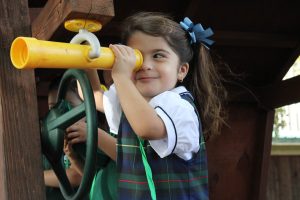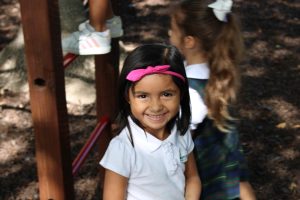Primary
3 – 6 years
 The primary classrooms are designed to allow the children independence to move, touch, manipulate and explore. The Montessori certified teachers/guides understand that the child’s “absorbent mind” is at its peak during their primary years. The environment gives the children the freedom to choose their own activities with guidance from the teacher/guide. This environment encourages the children to develop independence, which causes them to use their own initiative, building self-discipline and concentration. Throughout the day, students will receive individual lessons in language, mathematics, geography, and the cultural areas. The classroom furniture, shelving, and materials are designed with the child’s size in mind.
The primary classrooms are designed to allow the children independence to move, touch, manipulate and explore. The Montessori certified teachers/guides understand that the child’s “absorbent mind” is at its peak during their primary years. The environment gives the children the freedom to choose their own activities with guidance from the teacher/guide. This environment encourages the children to develop independence, which causes them to use their own initiative, building self-discipline and concentration. Throughout the day, students will receive individual lessons in language, mathematics, geography, and the cultural areas. The classroom furniture, shelving, and materials are designed with the child’s size in mind.
The use of the concrete materials to learn abstract concepts and operations is fundamental to the Montessori teaching method. In the primary classroom, materials play a significant role in the learning process. Some materials aresolid geometric forms, knobbed puzzle maps, colored beads, metal insets, and various specialized rods and blocks. The materials are designed to assist the children in understanding concepts presented.
To encourage the children to use the materials they are arranged on low open shelves providing easy access.
All of the materials have been specially designed to attract the child’s interest while at the same time teach an important concept. Each piece of material isolates a certain concept the child is bound to discover. For example, the pink tower, pink cubes of identical color and texture in varying sizes, isolates the concept of size.
Moreover the materials are self-correcting. When a piece does not fit or is left over the child can easily perceive the error. There is no need for correction by the guide. This allows the child to solve problems by oneself, build independence, and think analytically.
The classroom is divided into five distinct areas: Practical Life, Sensorial, Mathematics, Language, and Cultural.
Practical Life
 The practical life area is an integral part of the Montessori curriculum. This area helps develop the child’s fine motor skills, which will be later used in writing.
The practical life area is an integral part of the Montessori curriculum. This area helps develop the child’s fine motor skills, which will be later used in writing.
The child continues to work on various activities that promote concentration, cognitive order, independence, sense of order, and coordination. The child will begin with simple one and two-step activities that may last a few minutes. The goal is to build up to activities that can have ten steps and last for a longer period of time.
Sensorial
Maria Montessori believed that it was very important to teach children to understand their senses. She felt that children are not naturally taught to truly understand their senses, so she devoted a whole area to this endeavor. In the sensorial area of the Montessori classroom, children develop and internalize concepts of qualities, similarities, and differences in regard to length, width, temperature, mass, color, shape, and
sound. The sensorial materials also enhance development of other skills such as language, mathematics, and music. For example, by tracing a sandpaper letter with their finger, a child can feel the shape of the letter while at the same time learning its sound.
Mathematics: Concrete to Abstract
The Montessori mathematics materials allow primary children to begin their mathematical journey from the concrete to the abstract. They manipulate, experiment, and invent. The Montessori approach to mathematics is logical, clear, and very effective. The child will internalize math skills by using concrete materials. The children experience the thrill of discovery when using these concrete materials, which include rods, spindles, cards, beads, and many other various materials.
Language
The Montessori primary classroom emphasizes and encourages spoken language, for it is the foundation for linguistic expression. The child hears, learns, and uses specific vocabulary in all activities. Thus, they develop a clear and articulate expression. First, the child is introduced to the phonetic alphabet, and then they begin to read cvc (consonant, vowel, consonant) words. This is the springboard to sentence building, spelling, and composition. Reading and writing skills are acquired spontaneously. The children come with exciting declarations of “I can read!” and “I can write!” Skills that include pencil grip, handwriting, and fundamentals of grammar are also emphasized in the classroom.
Cultural
In this area of the primary classroom the children are introduced to geography, history, and world cultures. In addition, our unique multi-cultural school community provides an environment which these topics come alive. Along with cultural studies, the children also study the planets, time concepts, and the natural sciences.
